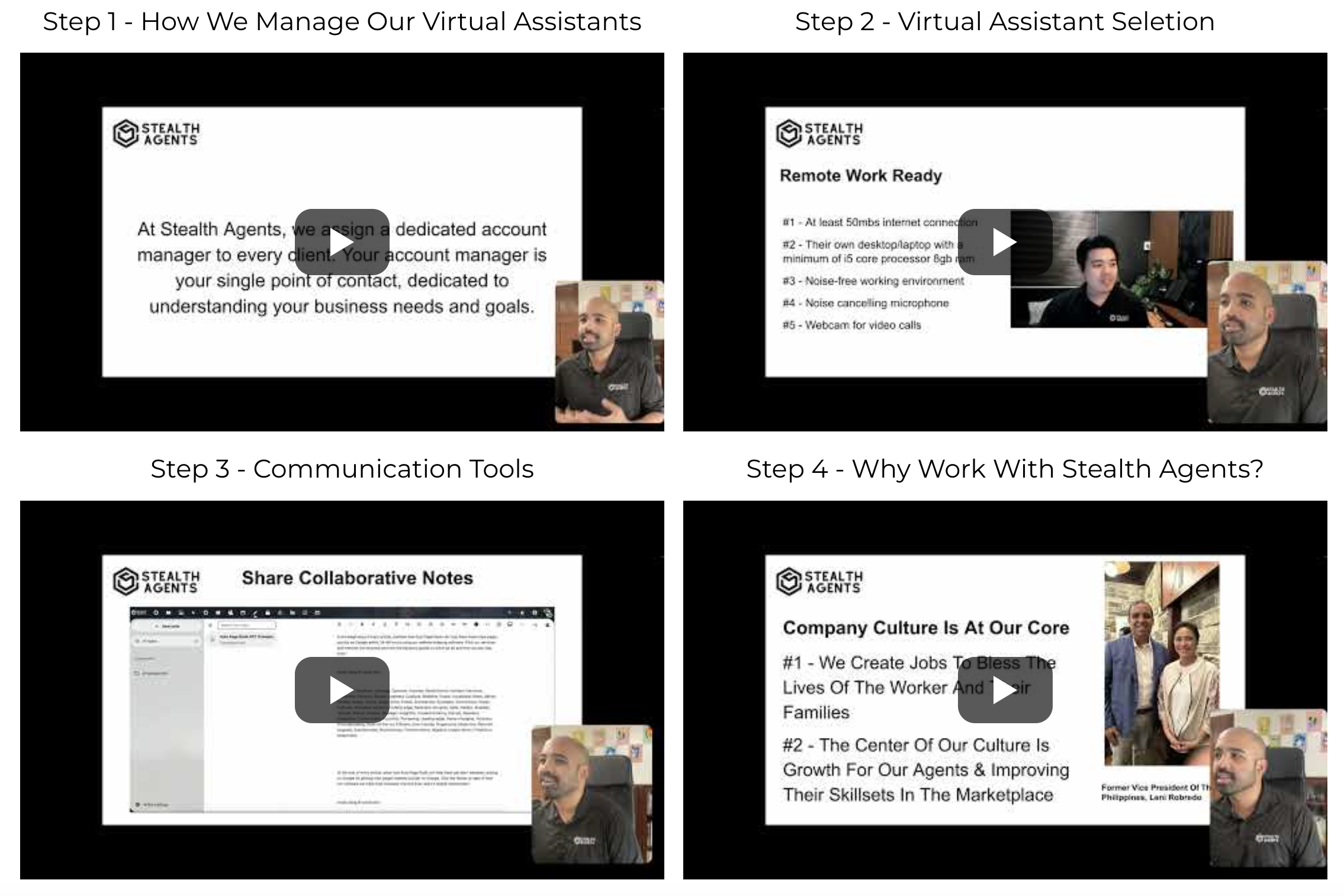Choosing the right communication tool is crucial for seamless virtual collaboration, and two titans stand out: Microsoft Teams and Google Meet.
Both platforms offer robust features yet cater to different needs and preferences.
Microsoft Teams is renowned for its deep integration with Office 365, making it an ideal choice for organizations deeply embedded in the Microsoft ecosystem.
On the other hand, Google Meet is celebrated for its simplicity and ease of use, especially for those already utilizing Google Workspace.
When selecting between the two, consider how each platform supports virtual assistant tasks, from scheduling meetings to enhancing productivity.
Virtual assistant services often leverage these tools to streamline operations, optimize communication, and offer competitive virtual assistant pricing models to fit various budgets.
Understanding these differences can empower businesses to choose the right platform that aligns with their unique needs and goals.
This comprehensive resource has been thoughtfully created, curated, and compiled by Stealth Agents to guide you through the decision-making process smoothly.
What is Microsoft Teams?
Microsoft Teams is a comprehensive communication and collaboration platform developed by Microsoft as part of the Microsoft 365 suite of products.
It offers a seamless online environment for teams to work, combining workplace chat, video meetings, file storage, and application integration into one unified platform.
Teams allow users to create different channels for various projects or topics, making it easy to organize conversations and tasks.
The platform enhances productivity by integrating with other Microsoft services and third-party applications, fostering a more connected and efficient work environment.
With its robust security features, Microsoft Teams ensures the protection of all communications and shared data, making it a reliable choice for businesses of all sizes.
Key Features:
- Seamless Integration with Microsoft 365: Teams is deeply integrated with Microsoft 365 applications like Word, Excel, and PowerPoint, allowing users to access and collaborate on documents directly within the platform.
- Video Conferencing Capabilities: It offers high-quality video conferencing with features such as screen sharing, live captions, and custom backgrounds to enhance virtual meetings.
- Collaborative Channels and Teams: Users can create dedicated channels for specific projects or departments, promoting organized communication and focused collaboration.
- App Integration: Teams supports various third-party apps and services, enabling users to customize their workspace and streamline workflows.
- Robust Security Measures: With enterprise-grade security and compliance, Teams protects data with advanced encryption and multi-factor authentication.
Pros:
- Enhanced Productivity through Integration: Integrating with Microsoft 365 services boosts productivity by allowing users to work seamlessly across various tools without leaving the platform.
- Comprehensive Communication Tools: Teams offers a full suite of communication options, including chat, video calls, and file sharing, catering to all collaboration needs.
- Scalability for Businesses: It’s suitable for organizations of any size and can be scaled easily to accommodate growing teams and increasing collaborative demands.
- Customizable to Fit Diverse Workflows: The platform’s integration with numerous apps allows businesses to tailor their workflow and optimize efficiency.
- Strong Security Framework: With constant updates and a focus on security, Teams ensures that business communications remain confidential and protected against breaches.
Cons:
- Steep Learning Curve for New Users: Due to Teams’ extensive features and functionalities, new users might find it challenging to master all its capabilities initially.
- Dependence on Internet Connectivity: Teams require a stable internet connection as a cloud-based service, which can be a drawback in areas with poor connectivity.
- Complexity for Small Teams: Smaller teams or businesses with simpler communication needs might find Teams’ wide range of features overwhelming or unnecessary.
- Potential for Information Overload: With multiple channels and conversations, users may experience difficulty managing and prioritizing information effectively.
- Cost Concerns for Premium Features: While Teams offers a free version, access to advanced features and functionalities requires a subscription to Microsoft 365, which may be a consideration for budget-conscious organizations.
What is Google Meet?
Google Meet is a video conferencing service developed by Google designed to facilitate seamless and reliable online meetings.
As part of the Google Workspace suite, it integrates effortlessly with other Google services, such as Calendar and Gmail, enhancing user convenience.
Google Meet supports high-definition video and audio quality, ensuring clear communication, even in large virtual gatherings.
Its user-friendly interface is ideal for both professional and personal use. It allows participants to join meetings with a single click.
With robust security measures, Google Meet ensures your virtual meetings are safe and secure.
Key Features:
- High-Definition Video and Audio: Google Meet provides high-quality video and audio, making virtual interactions more personal and practical.
- Seamless Integration with Google Workspace: It integrates smoothly with Google Calendar, Gmail, and other Google apps, streamlining scheduling and meeting access.
- Screen Sharing Capabilities: Users can easily share screens, enabling effective presentations and collaborative work during meetings.
- Live Captioning: Google Meet offers real-time captioning, making meetings more accessible for participants with hearing impairments.
- Robust Security Features: The platform includes encryption in transit and a range of privacy controls, ensuring your meetings are protected against unauthorized access.
Pros:
- Easy to Use: Google Meet’s intuitive interface requires minimal training, allowing users to adapt and participate in meetings without hassle quickly.
- Accessible Anywhere: Google Meet is a web-based application That can be accessed from any device with an internet connection, providing flexibility for remote teams.
- No Software Installation Required: Users can join meetings directly in their web browser, eliminating the need for additional software installations and updates.
- Reliable Performance: With Google’s infrastructure, Meet offers reliable connectivity and performance, even with multiple participants.
- Cost-Effective for Google Workspace Users: It is included in Google Workspace plans, offering significant value for businesses already using Google’s suite of tools.
Cons:
- Limited Features for Free Users: The free version of Google Meet lacks some advanced features in paid plans, such as extended meeting durations and larger participant capacity.
- Dependency on Google Ecosystem: Users heavily invested in non-Google tools may find integration less seamless than Google Workspace users.
- Internet Dependent: As a cloud-based service, Google Meet requires a stable internet connection, which can be a limitation in areas with poor connectivity.
- Basic Customization Options: Unlike competitors, Google Meet offers limited customization for meeting interfaces and functionalities.
- Occasional Compatibility Issues: While rare, some users may experience compatibility issues with certain browsers or devices, which can impact their meeting experience.
Microsoft Teams vs Google Meet: Detailed Features Comparison
1. Integration and Ecosystem Compatibility
In comparing Microsoft Teams vs Google Meet, integration capabilities stand out significantly.
Microsoft Teams excels with its seamless integration with the Office 365 suite. Users can access Word, Excel, and PowerPoint directly within the platform, enhancing productivity for businesses embedded in the Microsoft ecosystem.
On the other hand, Google Meet integrates effortlessly with Google Workspace, making it ideal for users who rely on Google services like Drive, Calendar, and Gmail.
This difference means organizations already utilizing these ecosystems may find one platform more beneficial than the other based on their existing tools.
Thus, the choice between Microsoft Teams and Google Meet often comes down to an organization’s current digital infrastructure.
2. User Interface and Accessibility
When considering Microsoft Teams vs Google Meet, the user interface and accessibility are crucial factors.
Microsoft Teams offers a comprehensive interface with a wealth of features, which, depending on user proficiency,h can be both a boon and a burden.
It is designed for extensive use in professional environments, sometimes requiring a learning curve.
Conversely, Google Meet is known for its simple, clean interface, making it easy for users to start or join meetings without hassle.
This ease of use is especially beneficial for organizations with frequent external participants who may not be familiar with more complex software.
3. Meeting Capabilities and Features
Examining Microsoft Teams vs Google Meet regarding meeting capabilities reveals distinct differences.
Microsoft Teams offers advanced features such as custom backgrounds, breakout rooms, and the ability to host live events with large audiences, making it suitable for large-scale virtual conferences.
Google Meet provides essential features like screen sharing, live captions, and adjustable layouts, focusing on straightforward, reliable communication.
While both platforms offer high-definition video and audio quality, Teams’ additional hosting capabilities can be a deciding factor for organizations requiring more sophisticated meeting setups.
4. Security and Privacy Measures
In the Microsoft Teams vs. Google Meet debate, security and privacy remain critical, especially concerning online business privacy policy requirements.
Microsoft Teams employs robust security protocols, such as end-to-end encryption, and is compliant with industry standards like GDPR and HIPAA. This makes it suitable for sectors dealing with sensitive data and requiring a security system virtual assistant.
Similarly, Google Meet provides strong security measures, including encryption in transit and various privacy controls, to ensure secure meetings.
However, for organizations with stringent compliance needs, Microsoft Teams’ extensive security features might offer additional reassurance.
5. Pricing and Value for Money
When evaluating Microsoft Teams vs Google Meet, pricing and the value provided are key considerations.
Microsoft Teams is available as part of the Office 365 subscription. It offers a wealth of additional productivity tools, which can be cost-effective for businesses that leverage the entire suite.
Google Meet, included with Google Workspace, provides a competitive pricing model for organizations already using Google’s ecosystem.
Both platforms offer free versions, but the advanced features and user capacities vary, influencing the overall value proposition depending on the organization’s specific needs and budget constraints.
How Stealth Agents Choose Microsoft Teams vs Google Meet?
When selecting between Microsoft Teams and Google Meet, Stealth Agents takes a strategic approach to ensure the best fit for their operations.
The decision hinges on several key factors, including the seamless integration each platform offers with existing tools.
For instance, Microsoft Teams is favored for its robust compatibility with the Office 365 suite, essential for teams heavily reliant on Microsoft applications.
On the other hand, Google Meet’s effortless integration with Google Workspace is ideal for those utilizing Google services extensively.
Stealth Agents also considers the user interface and ease of use, ensuring their clients and Filipino communication specialists can navigate the platform efficiently.
Security is another crucial aspect, as both platforms provide strong encryption and privacy controls; however, specific compliance requirements can tilt the balance in favor of one.
Ultimately, the choice between Microsoft Teams and Google Meet by Stealth Agents is guided by the unique needs of their team and the specific communication demands of their clients.
ConclusionIn comparison, Microsoft Teams and Google Mees offer robust solutions for virtual collaboration, each with its strengths.
Microsoft Teams stands out with its seamless integration with other Microsoft Office apps, making it a powerful tool for enterprises that rely heavily on the Microsoft ecosystem.
On the other hand, Google Meet is praised for its simplicity and ease of use, especially for businesses already utilizing Google Workspace.
While both cater to different needs, deciding between Microsoft Teams and Google Meet ultimately depends on your business requirements and the tools you already use.
Whether you opt for Teams’ comprehensive capabilities or Meet’s straightforward functionality, incorporating a Filipino virtual research assistant can enhance productivity by providing dedicated support tailored to your unique operational needs.












